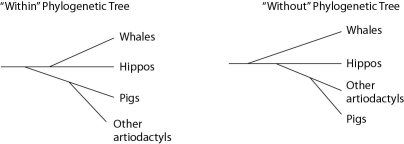Multiple Choice
Traditionally, whales and hippopotamuses have been classified in different orders, the Cetacea and the Artiodactyla, respectively. Recent molecular evidence, however, indicates that the whales' closest living relatives are the hippos. This has caused some zoologists to lump the two orders together into a single clade, the Cetartiodactyla. There is no consensus on whether the Cetartiodactyla should be accorded order status or superorder status. This is because it remains unclear whether the whale lineage diverged from the lineage leading to the hippos before or after the other members of the order Artiodactyla (pigs, camels, etc.) diverged (see Figure 20.2) .
 Figure 20.2 contrasts the "Within the artiodactyls" origin of the whale lineage with the "Without the artiodactyls" origin of the whale lineage.
Figure 20.2 contrasts the "Within the artiodactyls" origin of the whale lineage with the "Without the artiodactyls" origin of the whale lineage.
-What can be properly inferred from Figure 20.2?
A) In the "Without" tree, pigs are more distantly related to hippos than is depicted in the "Within" tree.
B) In the "Without" tree, pigs are more closely related to hippos than are whales.
C) In the "Within" tree, pigs are more closely related to whales than they are to hippos.
D) The "Without" tree is more consistent with molecular evidence than is the "Within" tree.
E) In the "Within" tree, all artiodactyls, including hippos, are more closely related to each other than any are to the whales.
Correct Answer:

Verified
Correct Answer:
Verified
Q8: <img src="https://d2lvgg3v3hfg70.cloudfront.net/TB6148/.jpg" alt=" Figure 20.1 -Which
Q18: Neutral theory proposes that<br>A) molecular clocks are
Q19: The next questions refer to the following
Q21: In figure shown below, which similarly inclusive
Q21: What kind of evidence has recently made
Q25: The importance of computers and of computer
Q27: <img src="https://d2lvgg3v3hfg70.cloudfront.net/TB6147/.jpg" alt=" Figure 20.4 Humans,
Q29: The following questions refer to the phylogenetic
Q62: If organisms A, B, and C belong
Q73: Together, the lesser apes and great apes